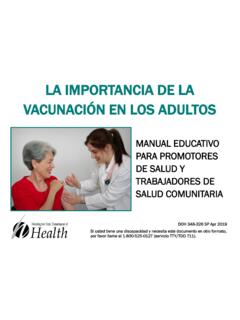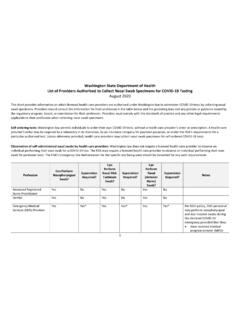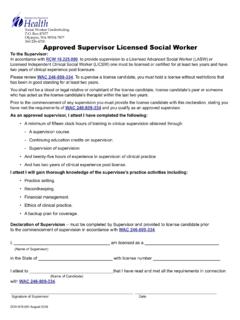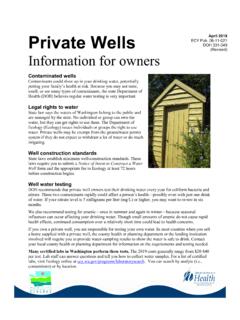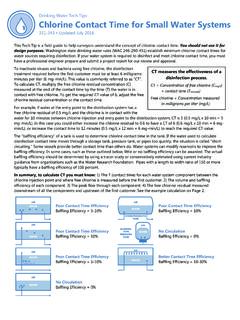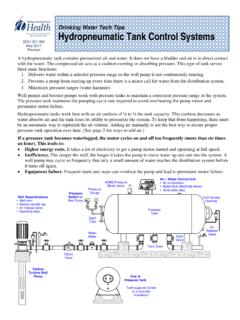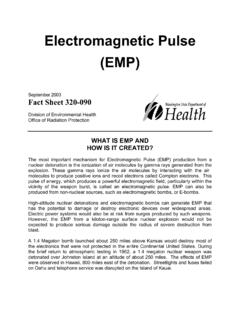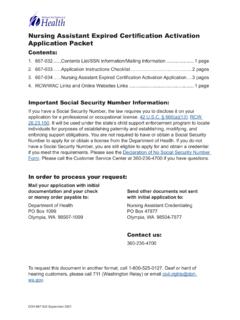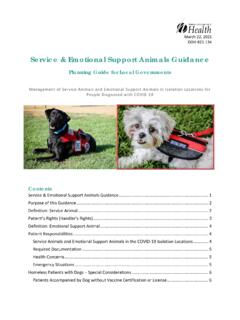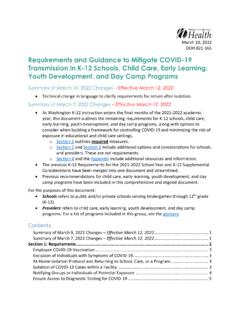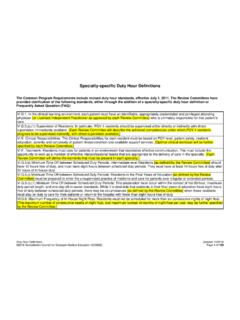Transcription of Interim Recommendations to Mitigate Health Care Worker ...
1 Interim Recommendations for SARS-CoV-2. Infection Prevention and Control in Healthcare Settings 2022. Updated April 22, 2022. Interim DOH 420-391. Recommendations 0. Updated April 22, 2022. Table of Contents BACKGROUND AND PURPOSE .. 3. KEY INFORMATION .. 3. INFECTION PREVENTION AND CONTROL PROGRAM AND PLAN .. 4. ELEMENTS OF COVID-19 PREVENTION IN ALL HEALTHCARE SETTINGS .. 5. SCREENING .. 5. HAND HYGIENE .. 6. PHYSICAL DISTANCING .. 6. ENVIRONMENTAL INFECTION CONTROL - CLEANING AND 7. VENTILATION .. 8. PERSONAL PROTECTIVE EQUIPMENT (PPE) AND TRANSMISSION-BASED PRECAUTIONS (TBP).
2 8. TABLE 1: PPE PATIENTS, HCPS, AND VISITORS SHOULD WEAR IN HEALTHCARE SETTINGS .. 10. TABLE 2: HCPS: HOW TO USE PPE .. 11. SOURCE CONTROL .. 12. SOURCE CONTROL VERSUS PPE .. 12. TABLE 3: SOURCE CONTROL AND PPE PROTECTION .. 13. SOURCE CONTROL FOR PATIENTS AND VISITORS .. 14. SOURCE CONTROL FOR HEALTHCARE PERSONNEL .. 14. FACEMASK USE IN HEALTHCARE SETTINGS .. 15. IMPROVING THE FIT OF MASKS IN HEALTHCARE SETTINGS .. 16. PRECAUTIONS DURING AND FOLLOWING AEROSOL GENERATING AND OTHER PROCEDURES .. 16. AEROSOL-GENERATING PROCEDURES AND PROCEDURES THAT CREATE UNCONTROLLED RESPIRATORY SECRETIONS.
3 17. HEALTHCARE PERSONNEL EXEMPTIONS TO RESPIRATOR USE FOLLOWING AN AEROSOL-GENERATING PROCEDURE .. 19. PATIENT ISOLATION AND QUARANTINE .. 20. ISOLATION VERSUS QUARANTINE .. 21. TABLE 4: SUMMARY OF SARS-COV-2 ISOLATION VERSUS QUARANTINE .. 21. HEALTHCARE PERSONNEL EXPOSURE AND EXCLUSION FROM 22. STRATEGIES TO Mitigate HEALTHCARE PERSONNEL STAFFING SHORTAGES .. 22. TABLE 5: SUMMARY OF CDC'S Recommendations FOR HCP EXCLUSION FROM WORK ACCORDING TO STAFFING. MITIGATION 24. CONSIDERATIONS FOR SHORTENED EXCLUSION FROM WORK FOR HEALTHCARE PERSONNEL AFTER A HIGH-RISK. EXPOSURE TO SARS-COV-2.
4 25. CONSIDERATIONS FOR SHORTENED EXCLUSION FROM WORK FOR HEALTHCARE PERSONNEL WITH SARS-COV-2. INFECTION .. 26. TRANSFERRING BETWEEN FACILITIES .. 26. TESTING .. 27. TESTING PRIORITIZATION .. 27. EXAMPLE OF LTCF PRIORITIZATION FROM HIGHEST (1) TO LOWEST (3) .. 28. TABLE 6: TESTING SUPPLY PRIORITIZATION .. 28. DETERMINING EXPOSURE .. 29. 1. GUIDANCE FOR SPECIFIC SETTINGS .. 30. TRANSFERRING BETWEEN FACILITIES .. 30. TRANSFERRING FROM A LTCF TO ANOTHER HEALTHCARE SETTING .. 30. HOSPITAL ADMISSION .. 31. TRANSFERRING FROM A HOSPITAL OR OTHER HEALTHCARE SETTING TO LTCF .. 31. TABLE 7: RECOMMENDED COHORTING STRATEGY.
5 38. PLACEMENT OF RESIDENTS IN QUARANTINE .. 34. OBSERVATION/QUARANTINE BEST PRACTICES WHEN SINGLE-PERSON ROOM IS UNAVAILABLE .. 34. TABLE 8: CONSIDERATIONS FOR COHORTING WHEN A SINGLE ROOM IS NOT AVAILABLE .. 35. CONSIDERATIONS FOR MEMORY CARE UNITS .. 36. SYMPTOMS IN MEMORY CARE RESIDENTS .. 37. PPE CONSIDERATIONS .. 37. TABLE 9: ROUTINE TESTING FOR ALL LTCF STAFF .. 38. BEHAVIORAL Health .. 41. ACUTE CARE .. 43. ADDITIONAL RESOURCES .. 46. OUTBREAK DEFINITION IN HEALTHCARE 46. OUTBREAK AND PREPAREDNESS CHECKLISTS .. 46. VISITOR LOG .. 59. SIGNS AND OTHER TOOLS .. 61. DEFINITIONS.
6 62. ABBREVIATIONS .. 67. CHANGE LOG .. 68. MORE COVID-19 INFORMATION AND RESOURCES .. 68. 2. Background and Purpose This document includes Washington State Department of Health (DOH) Recommendations to prevent transmission of severe acute respiratory syndrome coronavirus 2 (SARS-CoV-2), the virus that causes coronavirus disease 2019 (COVID-19) in healthcare settings. Healthcare settings should use these Recommendations to create flexible policies specific to their facility based on their individual risk assessment reflecting CDC's community levels of transmission. In general, healthcare settings should follow Centers for Disease Control and Prevention (CDC).
7 Guidance to prevent transmission of SARS-CoV-2: Interim Infection Prevention and Control Recommendations for Healthcare Personnel (HCP). During the COVID-19 Pandemic Overview of Testing for SARS-CoV-2, the virus that causes COVID-19. Interim Guidance for Managing HCP with SARS-CoV-2 Infection or Exposure to SARS-CoV-2. Strategies to Mitigate HCP Staffing Shortages Interim Infection Prevention and Control Recommendations to Prevent SARS-CoV-2 Spread in Nursing Homes Summary for Healthcare Facilities: Strategies for Optimizing the Supply of Personal Protective Equipment (PPE) during Shortages The guidance in this document is not regulatory in nature except when required by a regulatory agency such as Washington State Labor & Industries (L&I), Washington State Department of Social and Health Services (DSHS), DOH- Health Systems Quality Assurance (HSQA), and Centers for Medicaid and Medicare Services (CMS).
8 When creating policy and procedures, healthcare settings should ensure they are meeting regulatory requirements. The guidance in this document is Interim in nature and, as such, will be updated with changes in national and state guidance and most recent evidence and data. Changes will be summarized in the change log. Key Information DOH COVID-19 public Health reporting and surveillance guidelines provide useful key information about COVID-19 including information on incubation period, mode of transmission, and period of communicability. For updated case counts: Washington: US: #cases_casesinlast7days Global: 3.
9 Infection Prevention and Control Program and Plan Healthcare facilities should have a person dedicated to infection prevention and control and a plan to Mitigate risk of infection transmission. Some healthcare settings have specific regulatory requirements for infection prevention and control. Please refer to regulatory agencies' (L&I, DSHS, HSQA, and CMS) requirements for regulatory requirements. An infection prevention and control program should at minimum include: 1) Guidelines, policies, and procedures 2) Education and training 3) Surveillance 4) Monitoring, audit, and feedback From: WHO's core components of infection prevention and control program 4.
10 Elements of COVID-19 Prevention in all Healthcare Settings Screening Follow CDC Recommendations to establish a process to identify anyone entering the facility, regardless of their vaccination status, who meets any of the following three criteria so that they can be properly managed: A positive viral test for SARS-CoV-2, or Symptoms of COVID-19, or Close contact with someone with SARS-CoV-2 infection (for patients and visitors) or a higher-risk exposure (for HCP). Options could include (but are not limited to): individual screening on arrival at the facility; or implementing an electronic monitoring system in which individuals can self-report any of the above before entering the facility.
